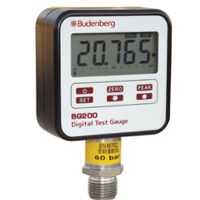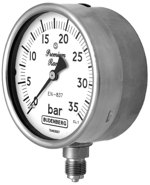23 March 2021
Categories: Knowledge Tags: digital pressure test gauge pressure gauges
With the invention of the steam engine during the industrial revolution, there was a necessity to monitor and control the flow of steam to stop accidents from happening. Because of this, the birth of the pressure gauge took place.
Two pressure gauge designs that have continued to be manufactured for over 170 years are the Bourdon tube and Diaphragm gauge. Since the inventions by Eugene Bourdon (Bourdon tube) and Bernard Shaffer (Diaphragm gauge), there hasn't been a great number of revolutionary changes to the initial design of the pressure gauge.
It took the digital revolution in the 1980s and 90s to bring the digital pressure gauge into the world, which was a completely new way of measuring pressure.
The analogue pressure gauge has been in operation within industry since 1849. So why was there a requirement for a digital pressure gauge and what is the difference? This article will explain the advantages and disadvantages of both.
Analogue vs Digital Pressure Gauges
Fundamentally, analogue and digital pressure gauges are designed to visually display the pressure in a liquid or gas. The way this is achieved both mechanically and digitally could not be more different.
Analogue Pressure Gauges
The design of the analogue pressure gauge is based around the mechanical movement of either a bourdon tube or diaphragm seal which in turn drives a needle around a dial.
Rather than using a mechanical movement from a bourdon tube or diaphragm seal, digital pressure gauges use a pressure transducer with the readings displayed on a digital display.
 Example of a Digital Pressure Gauge
Example of a Digital Pressure Gauge
The Budenberg BG200 pressure gauge is a new microprocessor-controlled digital pressure gauge that offers high precision, stability, and functionality in a compact and robust solution package.
The gauge is powered by a long-life internal Alkaline battery and offers an auto-power off function in order to preserve the battery life. The sensor technology combined with advanced designed features results in a highly accurate yet affordable digital pressure gauge.
Supplied as stand-alone the BG200 offers a cost-effective solution for accurate process monitoring and control. A wide range of handheld pressure pumps and kits are available to offer a complete testing solution for maintenance or calibration routine.
 Example of an Analogue Pressure Gauge
Example of an Analogue Pressure Gauge
Embodying an all 316 Stainless Steel construction, the 966GP incorporates a solid baffle wall and blow-out back for operator protection and standard features such as IP67 environmental protection, not normally available on comparative units.
An extensive choice of options can be fitted to any standard unit whilst fully customised units can be manufactured to suit any customer's requirements.
Monel wetted parts can be provided for customers who seek units to meet NACE-01-75 specification.
Digital and Analogue Pressure Gauge Comparison
| TECHNICAL SPECIFICATIONS | ANALOGUE | DIGITAL |
|---|---|---|
| Accuracy Class Standard (of FSD) | 1% | 0.1% |
| Accuracy Class Optional (of FSD) | 0.5% | 0.05% |
| Mountings | Direct, Surface, Flush, Bottom & Back | Direct |
| Pressure Connections | 1/8", 1/4", 3/8", 1/2" BSP & NPT | ½” BSP |
| Power Sources | - | 2X AA size alkaline battery |
| Minimum Scale Ranges | 0-25 mbar | 0-850 mbar |
| Maximum Scale Ranges | 0-4000 bar | 0-3000 bar |
| Operating Temperature | -40 to +200 °C | 0 to +50 °C |
| Storage Temperature | -40 up to +100 ºC | -10 °C to 60 °C |
| Environmental Rating | IP67 | IP65 |
| Pressure Units | mbar, bar, kg/cm², KPa, psi | mbar, bar, kg/cm², KPa, psi |
| Display | Single or Dual scale dial 63mm to 250mm | LCD display, 16 mm height |
The specifications above are based on the full range of Budenberg Gauge Co. Ltd's pressure gauges, which are used within industry. Analogue test gauges that are used for calibration have not been included.
Which Pressure Gauge to Choose, Analogue or Digital?The decision to purchase a Digital or Analogue pressure gauge is ultimately down to what application you are going to use it for. The chosen gauge will have to fit the specification and budget required.
For example, if an accuracy of 0.05%, 1/2" BSP connection with a direct mounting is required, a digital pressure gauge would be the best option.
If the operating temperature is anywhere between 50°C and 100°C and 1/4" BSP connection with a back mounting is required, an analogue pressure gauge would be the best option.
The Future of Pressure GaugesEven though analogue gauges have been used for over 170 years there will always be a use for them within industry. Analogue gauges are easy to read from a distance.
In comparison, dial wristwatches have been around for 100's of years and are still popular today, even when digital wristwatches were introduced in 1972.
With improved manufacturing processes and the development of new materials, analogue gauges will continue to become more robust, reliable, accurate, and cost-effective.
As with analogue gauges, digital pressure gauges will become more technologically advanced , receive improved sensor technologies, and longer battery life.
If you have any questions regarding choosing an analogue or digital pressure gauge for your application, please contact the technical team at Budenberg Gauge Co. Ltd.
Your details will not be shared with any organisation outside of Budenberg Gauge Co. Ltd. You may request to be removed from our database at any time.
To see our full privacy policy click here.
Budenberg Gauge Co Ltd is a premier manufacturer of instrumentation for a wide range of applications and markets. Quality and reliability have become the trademark of all Budenberg products and all our instruments are supplied with a standard warranty and carry a unique serial number for traceability purposes.